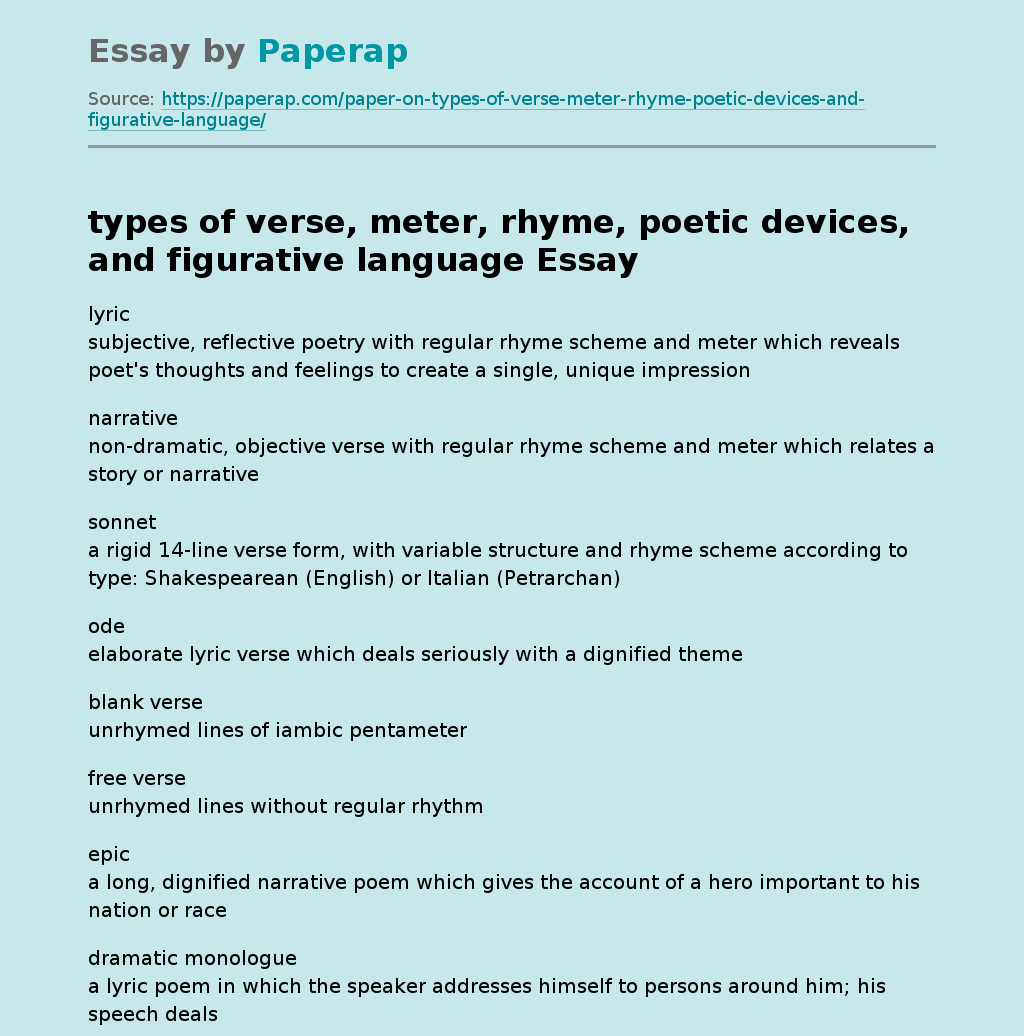types of verse, meter, rhyme, poetic devices, and figurative language
Essay,
Pages 4 (832 words)
Views
25
lyric
subjective, reflective poetry with regular rhyme scheme and meter which reveals poet’s thoughts and feelings to create a single, unique impression
narrative
non-dramatic, objective verse with regular rhyme scheme and meter which relates a story or narrative
sonnet
a rigid 14-line verse form, with variable structure and rhyme scheme according to type: Shakespearean (English) or Italian (Petrarchan)
ode
elaborate lyric verse which deals seriously with a dignified theme
blank verse
unrhymed lines of iambic pentameter
free verse
unrhymed lines without regular rhythm
epic
a long, dignified narrative poem which gives the account of a hero important to his nation or race
dramatic monologue
a lyric poem in which the speaker addresses himself to persons around him; his speech deals with a dramatic moment in his life and manifests his character
elegy
a poem of lament, mediating on the death of an individual
ballad
simple, narrative verse which tells a story to be sung or recited; the folk ballad is anonymously handed down, while the literary ballad has a single author
idyll
lyric poetry describing the life of the shepherd in pastoral, bucolic, idealistic terms
iambic
unstress stress
trochaic
stress unstress
anapestic
unstress unstress stress
dactyllic
stress unstress unstress
spondaic
stress stress
monometer
one foot
dimeter
two feet
trimeter
three feet
tetrameter
four feet
pentameter
five feet
hexameter
six feet
heptameter
seven feet
octometer (rare)
eight feet
couplet
two lines
tercet
three lines
quatrain
four lines
cinquain
five lines
sestet
six lines
septet
seven lines
octet (octave)
eight lines
x-lined stanza
nine lines or more
caesura
a pause in the meter or rhythm of a line
enjambement
a run-on line, one continuing into the text without a grammatical break
rime
old spelling of rhyme, which is the repetition of like sounds at regular intervals, employed in Versification, the writing of verse
end rhyme
rhyme occurring at end of verse line; most common rhyme form
internal rhyme
rhyme contained within a line of verse
rhyme scheme
pattern of rhymes within a unit of verse; in analysis, each end rhyme-sound is represented by a letter
masculine rhyme
rhyme in which only the last, accented syllable of the rhyming words correspond exactly in sound; most common kind of end rhyme
feminine rhyme
rhyme in which two consecutive syllables of the rhyme-words correspond, the first syllable carrying the accent; double rhyme
half rhyme (slant rhyme)
imperfect, approximate rhyme
assonance
repetition of two or more vowel sounds within a line
consonance
repetition of two or more consonant sounds within a line
alliteration
repetition of two or more initial sounds in words within a line
onomatopoeia
the technique of using a word whose sound suggests its meaning
euphony
the use of compatible, harmonious sounds to produce pleasing, melodious effect
cacophony
the use of inharmonious sounds in close conjunction for effect; opposite of euphony
metaphor
a figure of speech which makes a direct comparison of two unlike objects
simile
a direct comparison of two unlike object, using like or as
conceit
an extended metaphor comparing two unlike objects with powerful effect
personification
a figure of speech in which objects and animals have human qualities
apostrophe
addressing a person or personified object no present
metonymy
the substitution of a word which relates to the object or person to be named, in place of the name itself
synecdoche
a figure of speech in which a part represents the whole object or idea
hyperbole
gross exaggeration for effect; overstatement
litotes
a form of understatement in which the negative of an antonym is used to achieve emphasis and intensity
irony
the contrast between actual meaning and the suggestion of another meaning
a) verbal- meaning one thing and saying another
b) dramatic- two levels of meaning- what the speaker says and what he means, and what the speaker says and what the author means
c) situational- when the reality of a situation differs from the anticipated or intended effect; when something unexpected occurs
a) verbal- meaning one thing and saying another
b) dramatic- two levels of meaning- what the speaker says and what he means, and what the speaker says and what the author means
c) situational- when the reality of a situation differs from the anticipated or intended effect; when something unexpected occurs
symbolism
the use of one object to suggest another, hidden object or idea
imagery
the use of words to represent things, actions, or ideas by sensory description
paradox
a statement which appears self-contradictory, but underlines a basis of truth
oxymoron
contradictory terms brought together to express a paradox for strong effect
allusion
a reference to an outside fact, event, or other source
villanelle
French verse form, strictly calculated to appear simple and spontaneous; five tercets and a final quatrain, rhyming aba aba aba aba aba abaa. Lines 1, 6, 12, 18 and 3, 9, 15, 19 are refrain.
light verse
general category of poetry written to entertain, such as lyric poetry, epigrams, and limericks
haiku
Japanese verse in three lines of five, seven, and five syllables
limerick
humorous nonsense-verse in five anapestic lines rhyming aabba, a-lines being trimeter and b-lines dimeter
amphibrach
a foot with unstressed, stressed, unstressed syllables
anacrusis
an extra unaccented syllable at the beginning of a line before the regular meter begins
amphimacer
a foot with stressed, unstressed, stressed syllables
catalexis
an extra unaccented syllable at the ending of a line after the regular meter ends
types of verse, meter, rhyme, poetic devices, and figurative language. (2017, Dec 05). Retrieved from https://paperap.com/paper-on-types-of-verse-meter-rhyme-poetic-devices-and-figurative-language/
